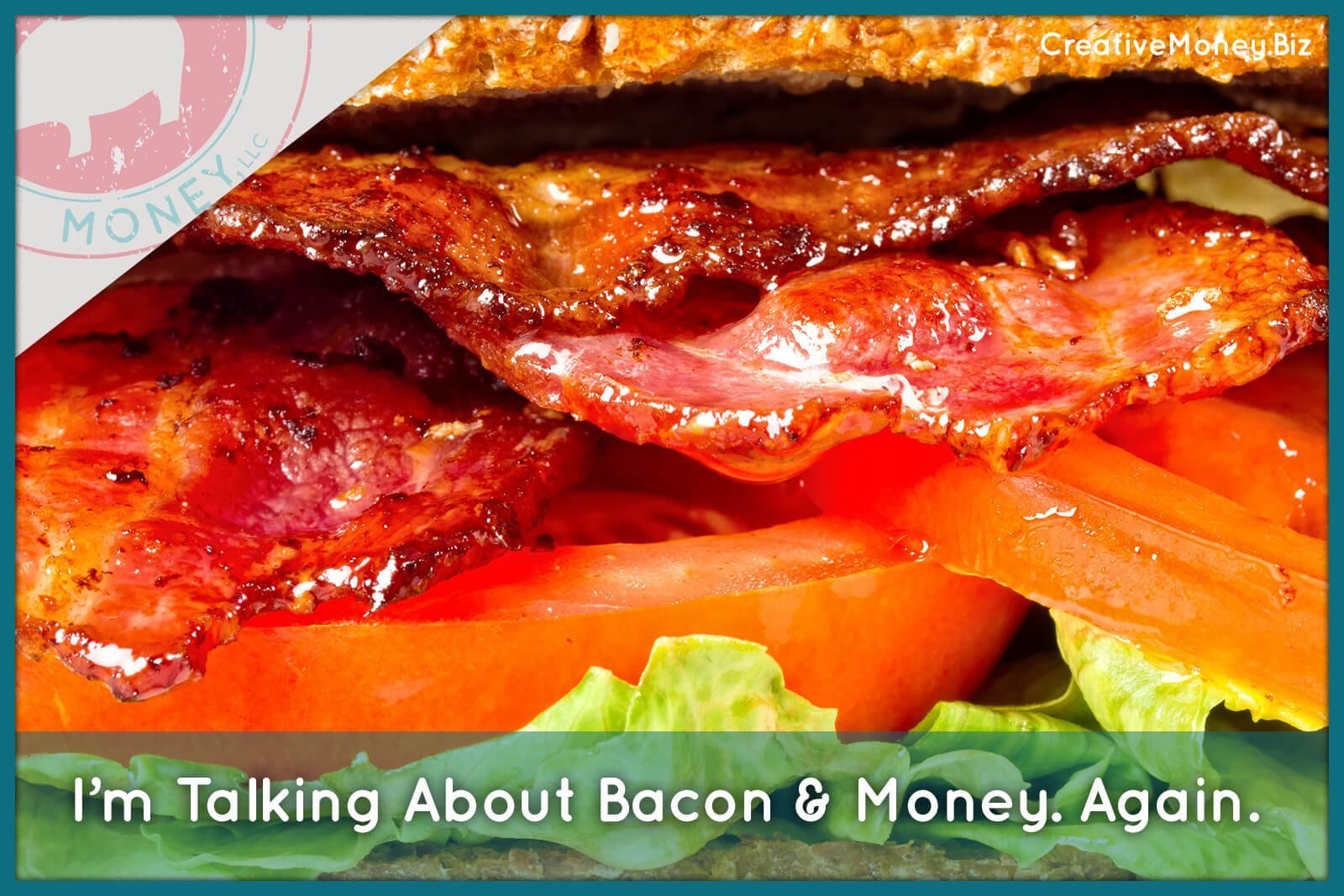 If you’ve been hanging out with me for a while, you know I love me some bacon. And in spite of all of those nitrates, bacon has helped me take better care of myself financially. So I am re-upping my annual homage to bacon and how it helps you save money.
If you’ve been hanging out with me for a while, you know I love me some bacon. And in spite of all of those nitrates, bacon has helped me take better care of myself financially. So I am re-upping my annual homage to bacon and how it helps you save money.
You see, there were years when I was working my butt off building my business and working lots of late hours. I’d stop working for the day, head home and pick up some take-out for dinner. This was happening three or four times a week. It wasn’t like I didn’t have a fridge full of healthy food at home waiting for me. And I ended up throwing out a lot of those veggies and well-intentioned healthy foods because I never got around to fixing them. I was spending more and eating less healthily at the same time.
What I finally realized was this: when I went grocery shopping, I was shopping for “Perfect Mindy.” The Mindy who eats healthy all of the time (who dat??). So I got real with myself. I gave myself permission to not be “perfect” when I shopped for groceries. I asked myself, “what would I be excited to come home to and eat when I am worn out from working hard all day?”
The answer?
- BLTA (Bacon Lettuce Tomato and Avocado) Sandwich
- Grilled Cheese
- Mac and Cheese
(are you noticing a cheese theme here?)
I realized that if I bought things I could get excited about, I actually ate less AND I didn’t spend as much. This doesn’t mean I don’t try to eat healthy at other times. I just decided to pick my battles. And I accepted that I need a little enticement to change my spending habits. And that is when I developed the BLTA recipe for conscious spending.
Conscious spending vs. budgeting
This is what I call conscious spending. It’s not about perfection or frugality, but what works best for you as the individual. It’s a lot like eating healthy. If you’ve ever had issues with overeating, and adopted a “mindful” approach, you know that the more conscious you are of what you’re eating, then the more conscious you are of your behavior relative to what you ultimately want—usually, to fit into your skinny jeans, avoid gaining weight, etc.
You can artificially decide to cut out some areas of spending, and for a while you’ll see results because you’ll feel virtuous about it. But after a while, you’ll start to feel resentful and you’ll go on a spending binge. You’ll end up face first in a pile of new clothes or books instead of a plate of Oreos or chocolate cake.
Conscious spending, on the other hand, is more like the mindful eating approach to losing weight. It’s more about being aware of what you’re doing and making choices that are aligned with your goals.
The BLTA recipe for conscious spending
One of my clients, Maria, wanted to pay off some debt. She was thinking about slashing an expense that gave her a lot of satisfaction and support…her dance classes. I encouraged her to keep her dance classes, since I could see how important they were to her well being. She realized that she would rather be happy and keep her dance classes, and have debt for six months longer, than to be miserable and pay off that debt sooner.
THAT is conscious spending. It is the belief that once you examine your consumer habits and really do understand where you derive the most enjoyment, you can actually better utilize every dollar. And the really great part is that it’s much simpler than budgeting if you use my BLTA recipe:
- B – Be clear about where your money is going — Use a service like Mint to track your spending for a few weeks, up to a month, to get real clarity around where your money is going. And this is not a budget! This is simply tracking your spending.
- L – Listen to your gut — This is about determining your perceived value for what you’re spending. And everyone’s perceived value is going to be different. When I started tracking my expenses, I discovered that I was spending about $150 a month at Starbucks. For some people that would be nothing, but for me, the number made me say, “Woah! That’s too much.” The perceived value I was getting from those Starbucks runs wasn’t equal to the actual cost.
- T – Think through the spending experience — Next you want to consider the experience and how you can consciously and happily adjust it. For me, when I really thought about my Starbucks experience, I realized that the pastries and the frou-frou drinks weren’t doing it for me — it was all about the experience. So I could happily switch to a $2 cup of drip coffee and cut my spending by about two thirds! Without any loss of enjoyment.
- A – Aim for awareness — This last step is maybe the hardest, but when you discover spending that your gut tells you is too much, it’s important to ask why. Why are you spending so much in that category? Grab a journal and write down how you feel when you make a purchase. What you’ll find is that some purchases have zero emotional impact, while others have their own complicated stories — and those stories are an amazing opportunity for insight.
I equate conscious spending to meditation. People say that the goal of meditation is the ability to return to the practice of letting go over and over again. With meditation, people waste a lot of time getting mad at themselves because they can’t clear their minds. But experienced meditators are over that. They KNOW that their mind will wander, so a successful experience is simply getting better and better of letting go and returning to the blank space.
And that’s how it should be with conscious spending… you return. Going “over budget” or spending more than you wanted to – it’s a return to consciousness. It’s a reminder to go back and understand why things aren’t going the way you thought they would.
The goal of conscious spending isn’t to limit anyone, but it’s to help people increase awareness about how they’re behaving in everyday life. When you start to break down your experiences like that, you actually get the most satisfaction from your spending. You’re more conscious in the present moment of what’s going on. In that world, you really can have just about anything you want. Because when you’re completely conscious about it is that you want, you realize you don’t want as much after all (just bacon).
By the way, if you want to read more about conscious spending (and bacon) you can get my free ebook on it in the vault that contains all of my free resources – which you can access here.







